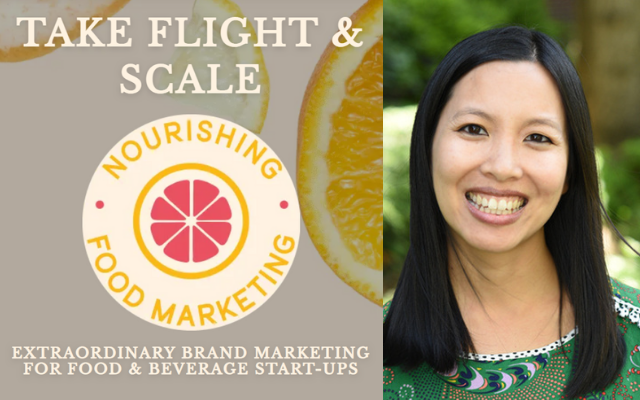It takes a lot of effort to stay true to your brand. As businesses grow and explore opportunities, they quickly learn how to compromise and change the way they do things. And that’s not a bad thing! Change is a sign of growth and getting better at what we do. But it’s the way that we change that really impacts how well we stay true to ourselves and our brands.
Christie Lee started her career helping build billion-dollar brands. She learned Big Food frameworks from working with companies like Hidden Valley Ranch and Kingsford Charcoal. She closely watched how brand empires like Coca Cola and MdDonald’s mechanized marketing tools to conquer the global markets. But she didn’t want to keep working for the big players, not when it was clear to her that the food system was broken. And she knew she wasn’t going to fix it by staying in the company of big and established brands.
So, she turned to the place where there was a real potential for change:
The emerging power of small food brands.
“My industry thesis is that small and emerging food and beverage brands are going to disrupt and change a broken food system,” Lee said.

Small and emerging F&B brands bring in a lot of new ideas and innovation into the marketplace because they naturally start from a place of differentiation. They’re always trying to figure out how to do things better as a way of getting ahead. And in a way, they’re also much more committed to bringing in sustainable practices. It makes sense. A company that builds their business model around sustainability would be more likely to perform to that promise because that’s their whole brand.
Unfortunately, most small and emerging F&B brands struggle to bring their ideas to the highly competitive market. And, when they do get there, it’s at a massive cost of resources and, sometimes, principles.
This is what Lee hopes to change things with her marketing firm. She started Nourishing Food Marketing to bring the strategic frameworks of big and successful companies to small and emerging brands.
“Most new and emerging brands can’t afford full-time marketing help because we’re typically expensive. It just doesn’t make sense to bring someone on full-time,” explained Lee. “I provide tools and coaching to new and emerging brands, so they, too, may have access to strategic marketing leadership. That way, they’re able to fill an internal resource gap and they’re able to access strategic marketing help more resource-efficiently.”
Dive deep in your goals before building a brand identity.
Lee’s brand marketing strategy is centered around a deep dive into the proverbial soul. The thought process, which many tend to overlook in place of more agile solutions, is a critical step in keeping a company’s brand grounded in its goals and values. The first step to anything, says Lee, is for any brand to determine their business objectives.
“Everything starts from there. ‘What do you want to accomplish in your business?’” says Lee.
Sitting down and thinking through the company’s business objectives helps lay the foundation for all future decisionmaking. Knowing what you want to do in the long run anchors the decisions you make by giving it purpose and direction.
Lee adds that “Everything has to ladder up.” Companies should align their marketing objectives with their business objective, and their tactics with their marketing objectives.

“It’s a thought-through framework that most small brands don’t really have in place,” observes Lee.
A lot of founders will say, “I got this email for this radio show that I can do advertising on.” And I’m like, “Hold on, let’s not look at that opportunity individually.” We should say, instead, “Does this do a better job than something I’m currently spending my money on in order to achieve my objectives?”
Having a clear ladderized map of the company’s objectives shows how every decision helps achieve your business goals.More importantly, it compels executives to determine their ideals and values. So that when they plan marketing campaigns or projects, they don’t lose sight of the bigger picture and everyone’s role.
“Remember – it’s not enough that you’re doing marketing. It’s much more impactful for your business if your marketing is linked to business objectives,” says Lee.
Keep up with the changes by staying true to your brand.
One of the biggest challenges for companies during the pandemic is figuring out how to pivot. Companies that were structurally lean and strategically agile were able to face the challenges of COVID-19 more readily. For example, businesses that have always worked remotely with a small and strategic workforce, or those who have always had strong e-commerce strategies were able to pivot much faster than others.
But for everyone else, it’s an adjustment. Lee has two important pieces of advice that companies need to keep in mind to stay true to their brand amidst all the changes.
First, any changes that companies plan to make have to be long-lasting.
“You don’t start selling into brick-and-mortar retail for six months and make a profit. Likewise, you don’t start your e-commerce store or sell into Amazon for six months and say, “After the pandemic’s over, I’m not going to do this anymore.” says Lee.
“Everything takes investment. Everything takes time to be profitable,” reminds Lee, “Everything that you do should meet your business objectives.”
Secondly, the pandemic has changed consumer behavior and the business landscape.
“So, as you think about your business objectives and your marketing objectives, ask yourself, how can you incorporate that into what you’re doing on a day-to-day basis,” says Lee.
Companies are also making changes in their brand values. Some emerging businesses are passionate about reflecting their social and political values in their brands. If businesses intend to integrate their values into their brand marketing, Lee says they need to be able to communicate them clearly.
“In this world where there’s so much uncertainty, so much lack of trust, and so much ambiguity, brands should be able to clearly communicate who they are and what they stand for,” said Lee.

But it’s also important that companies also put in the work. The only way to integrate values into their brand authentically is to put them into practice.
“Before you communicate anything, first you have to do the work. You have to identify how you’re going to work on the value internally,” said Lee. “For example, if you have searched internally and decided that a top value for you is gender equality, you have to make sure your company itself meets those values before you talk about it to your consumers.
The future of food branding is authenticity.
Christie Lee believes that small and emerging brands are leading the way in fixing the broken food system and innovating business practices to speak more truthfully and sustainably to their values, as brands and as people.
The most important thing is for small and emerging food companies to understand and remember their why. It requires deep understanding and consistent work to stay true to your brand.
“As a brand, you only get five values. You can’t be a brand that has a hundred values, because then you stand for nothing,” reminds Lee.
“We live in a world of personalization, of limited time and increasing competition for our attention and engagement. Brands need to understand their why and communicate it clearly across all of their marketing assets.”
Read more from our interview with Christie Lee at the Mover’s Spotlight column.
Check out more of Christie Lee’s marketing and branding strategies at the Nourishing Food Marketing website.

